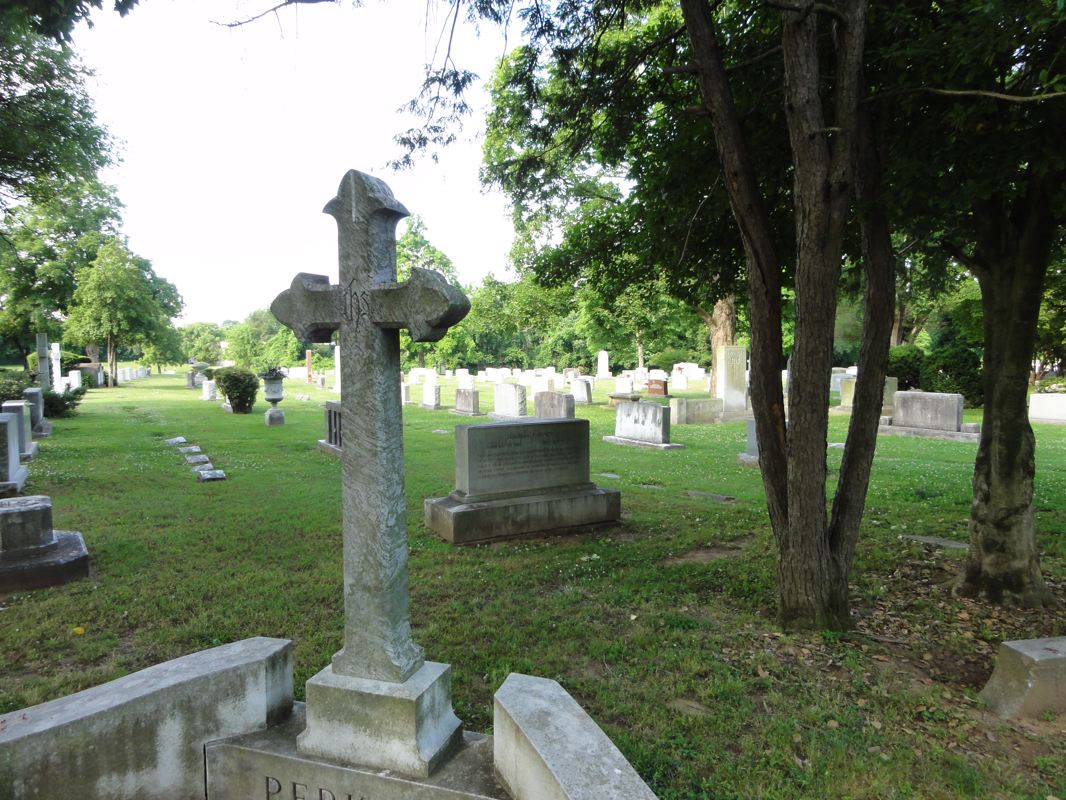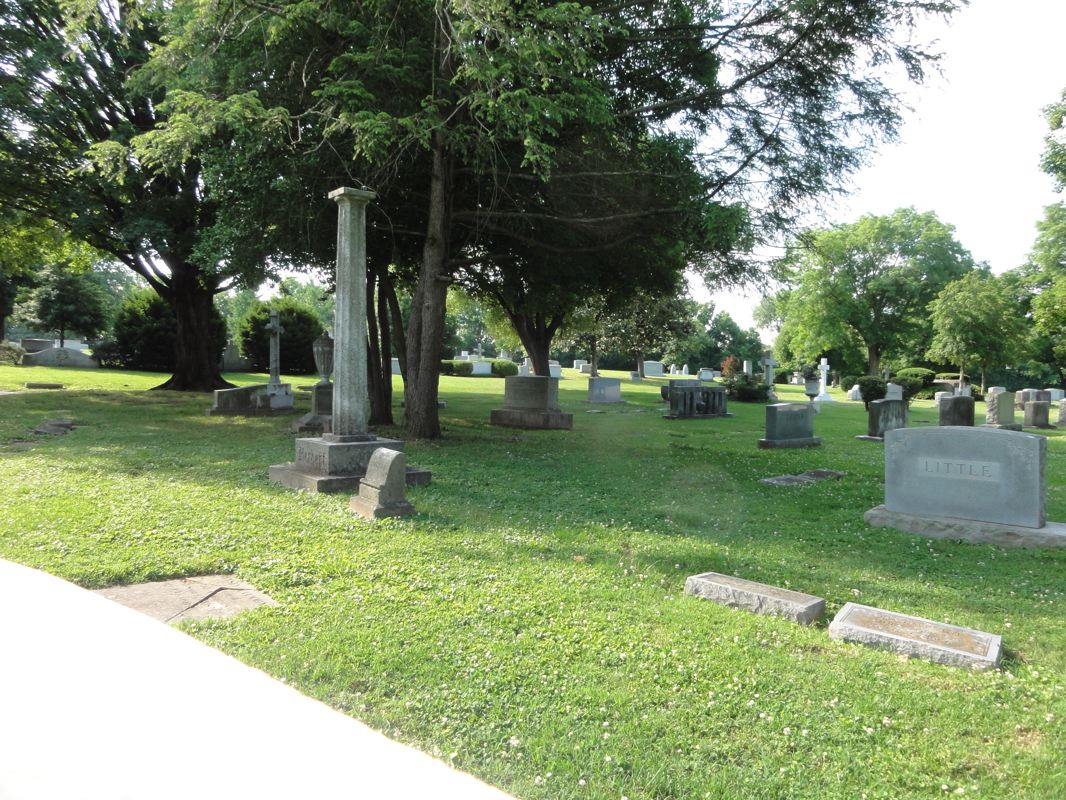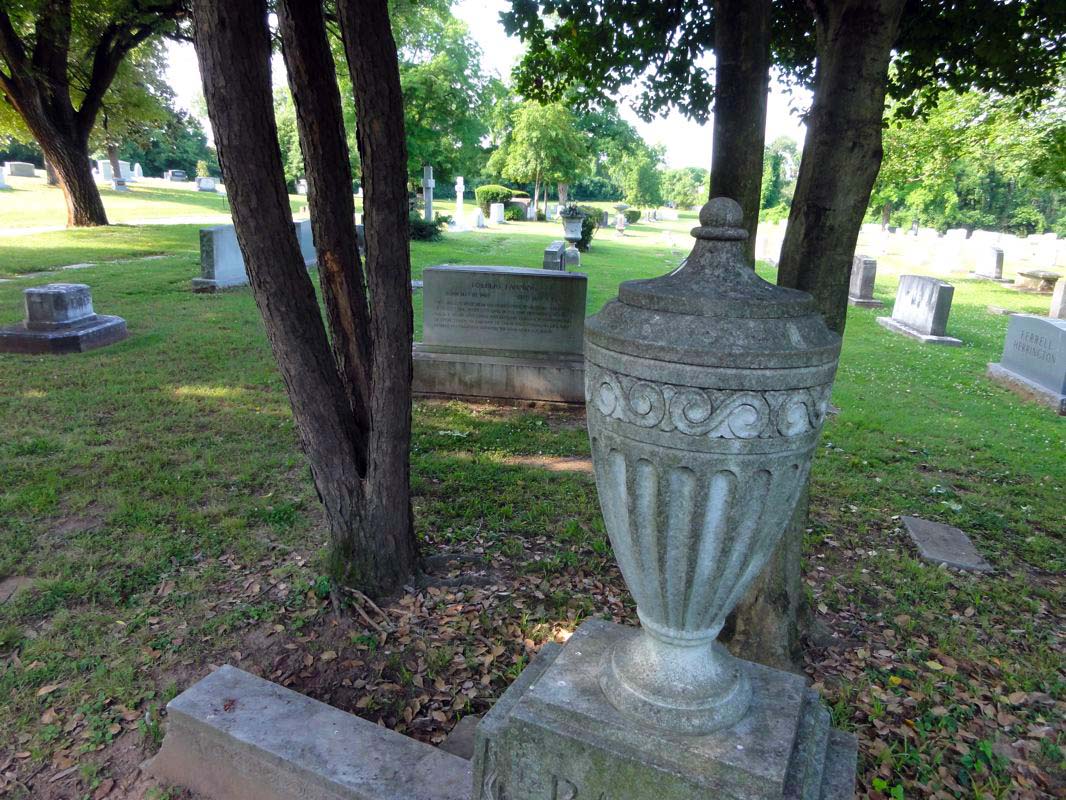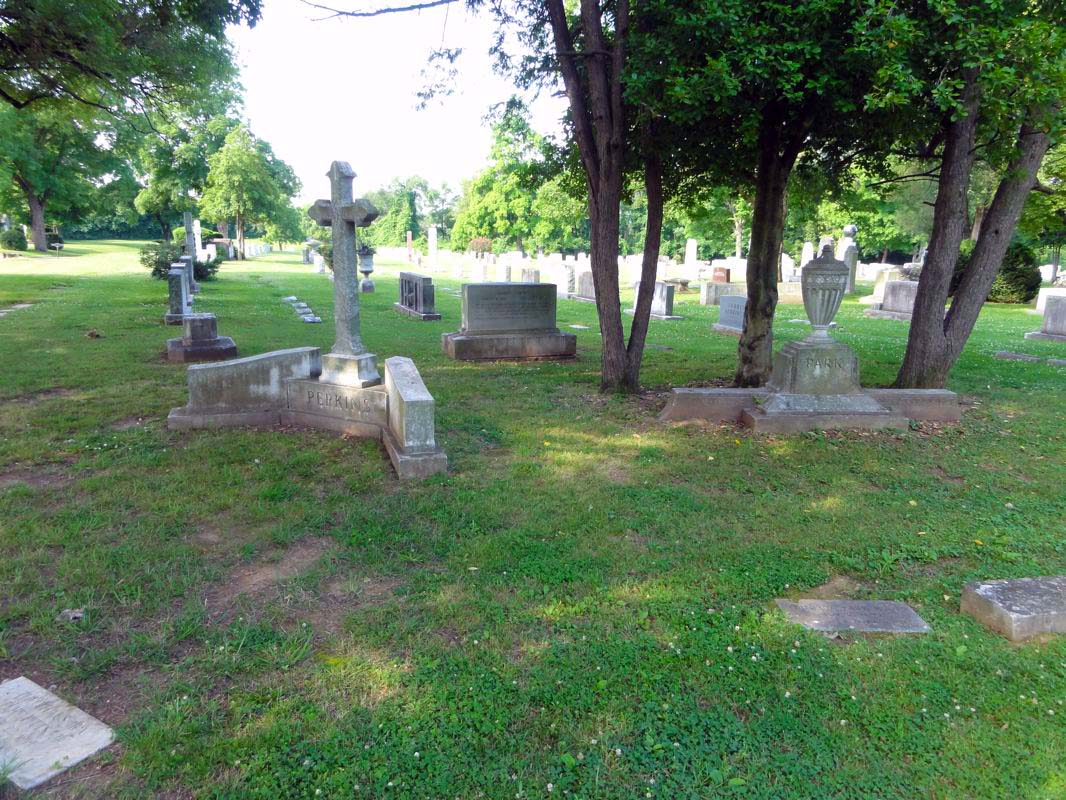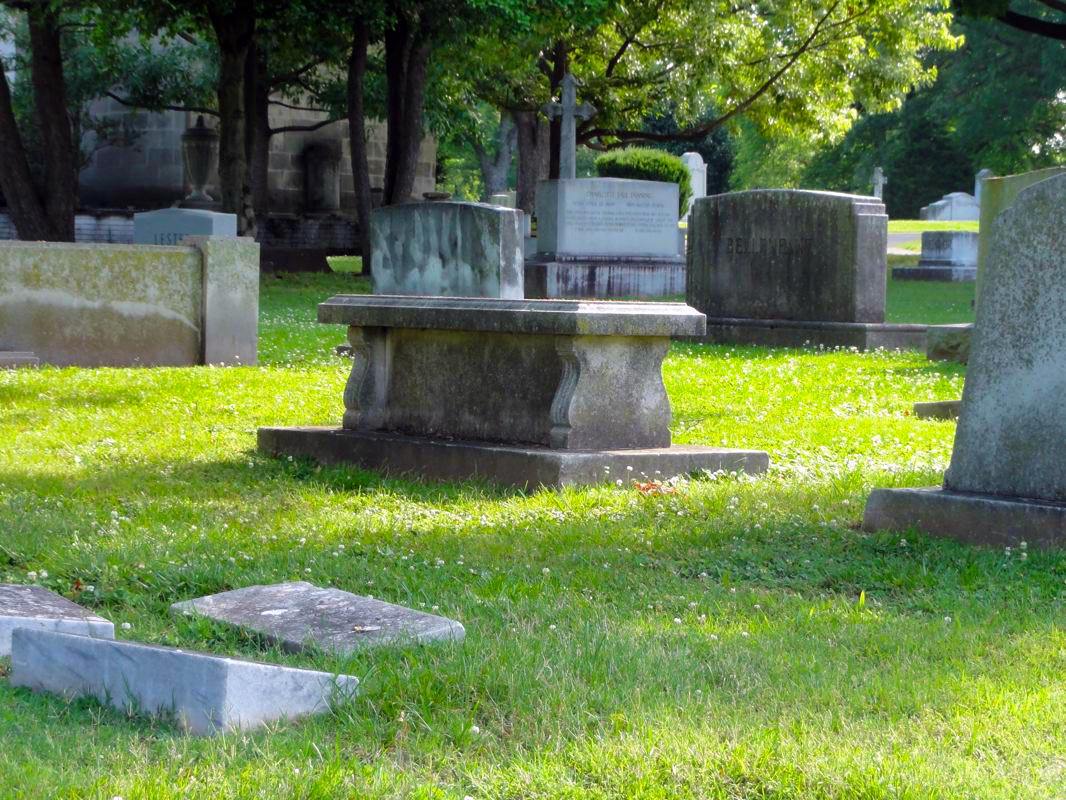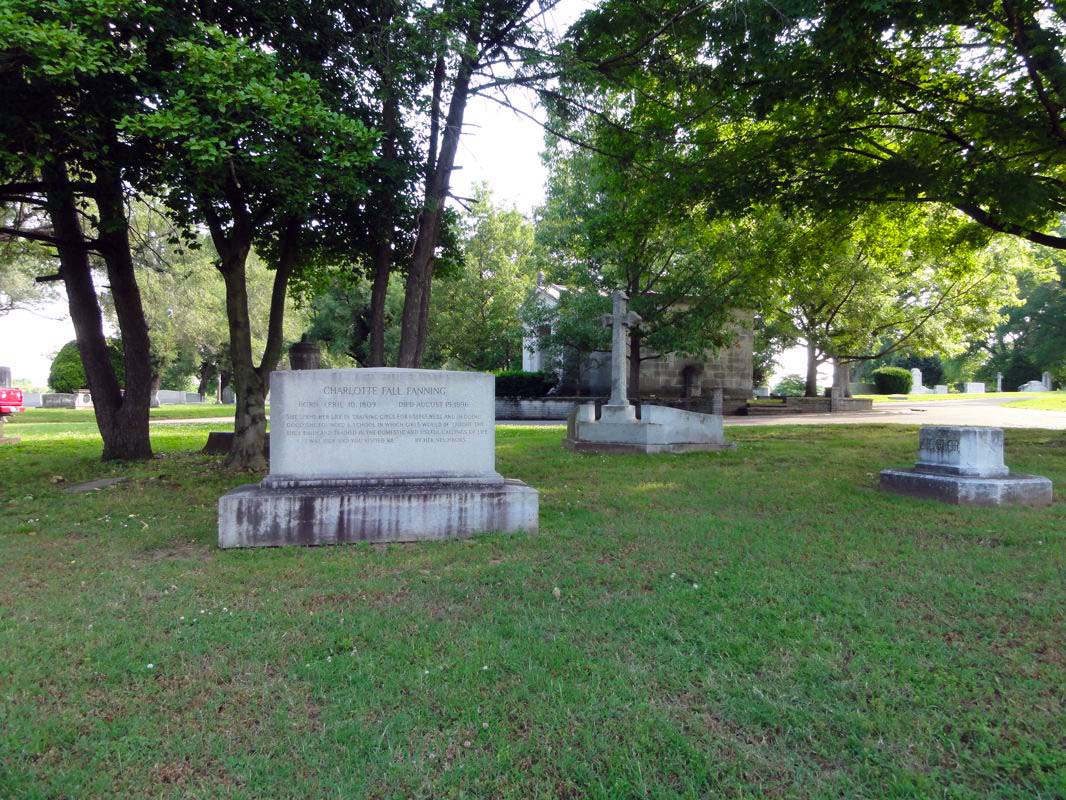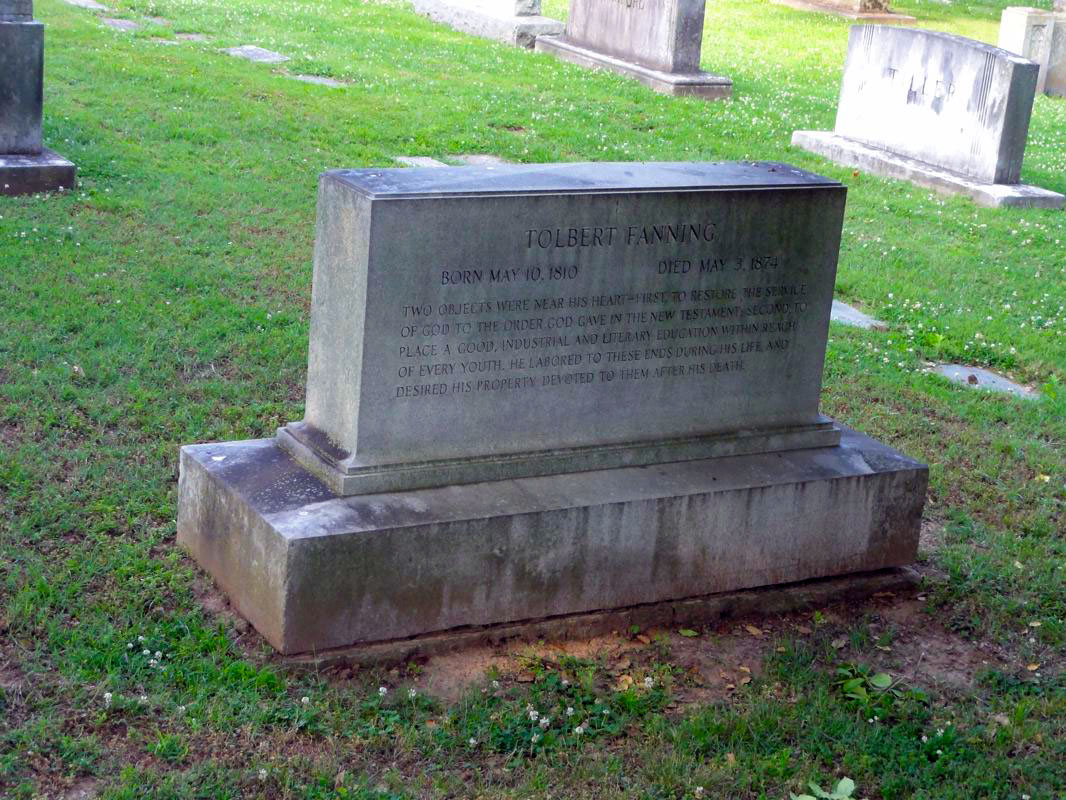Tolbert Fanning
1810-1874
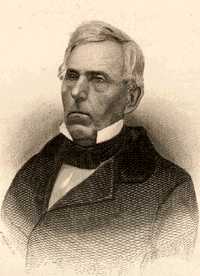
![]()
The Life of Tolbert Fanning
Tolbert Fanning was born in Cannon County, Tennessee on May 10, 1810. He was the son of William and Nancy Bromley Fanning. Not much is known of his early years, but in about 1818 the family moved to Lauderdale County, in Alabama's most northwest section. There, he attended a school on Cypress Creek, operated by Ross Houston, the brother of Alabama Governor George S. Houston (1808-1879). By 1824, the Christian movement was established on the creek, with James E. Matthews and Ephraim D. Moore leading the group.
In the fall of 1826, a young preacher by the name of Benjamin Franklin Hall came into the region teaching a doctrine of salvation, different to what they had been preaching. He taught that the gospel must be obeyed, and that when they were baptized, they would be relieved of the guilt of their sins. While preaching one night, the sixteen-year-old, Tolbert Fanning, responded to the invitation. The following morning, October 1st, James Matthews baptized Tolbert Fanning for the forgiveness of his sins in Cypress Creek. (Also baptized that day was his close friend, Allen Kendrick, the brother of Dr. Carroll Kendrick. The Kendricks were a mighty force in the gospel all their days).
Within three years, Tolbert Fanning was preaching occasionally in different locations. He was passionate about his beliefs, and was greatly desirous of opportunities to share the gospel. On one occasion early in his ministry, he was in Murfreesboro, Tennessee, where he witnessed a brother selling one of his black slaves, who was also a Christian. Fanning had, early in life, been convinced that the institution of slavery was ungodly. The following day, he preached at the East Main St. church of Christ on the ungodly practice of slavery in America. His preaching was met with great anger by most of the church. It was agreed that Tolbert Fanning would never preach for that church again. The year was 1830; thirty-one years before the country would be embroiled in civil war over the issue.
The following year, he had his first debate in Nashville, Tennessee with the local Presbyterian minister, Obadiah Jennings. Jennings had debated Alexander Campbell a couple of years earlier. The subject was on baptism.
Fanning moved to Nashville in January of 1832, where he entered the University of Nashville, in search of a law degree. The following summer, he went to Kentucky, and traveled with Alexander Campbell through the state, preaching and evangelizing. He graduated at the end of the school year, 1835. During the summer, he traveled through Kentucky again with Alexander Campbell. On November 2nd, he married Miss Sarah Ann Shreve of Nicholasville, Kentucky. Three days later she was overcome with a fatal illness. She returned to home of her parents, William Martin and Ann Bennett Shreve. Twelve days later, on November 20th, she went to be with the Lord. Burial followed in the Shreve family cemetery on 3rd Street in Nicholasville.
Though deeply grieved, Tolbert continued to preach throughout the region. The following year, he married English born, Charlotte Fall. As a side note, she was the sister of Philip S. Fall, a gospel preacher who, preaching for the Baptist Church in Nashville in the mid-1820s, converted the whole congregation to New Testament Christianity, and thus organized the church of Christ in that city. Tolbert was twenty-six and Charlotte was twenty-seven when they were married.
With the marriage of Tolbert and Charlotte Fanning, education of young people quickly became their life's greatest passions. Between 1837 and 1839, they conducted a female academy in Franklin, Tennessee. Later, in 1840, they moved to Elm Crag, in southeast Nashville, (the property is now the location of the international airport). Immediately, they opened another female academy that continued for another two years. In 1843, they expanded their operations to include a boys agricultural school that continued for two years. The school was unique, in that the students earned their education through daily working a farm.
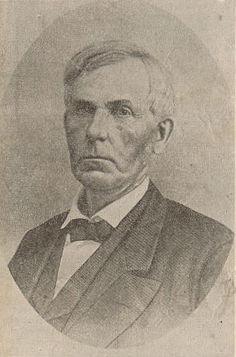
Perhaps, the Fannings are best known for establishing Franklin College. Beginning in January 1845, this college was where men like William and David Lipscomb, Elisha G. Sewell, and T. B. Larimore received their training. The school continued until the beginning of the Civil War, when all the students left to join the Confederate Army. The school resumed in the fall of 1865, only to have the main building burn to the ground a few weeks into the term. Providentially, a girl's college that existed just a few hundred yards from Franklin College was purchased. The school became known as Hope Institute. Franklin College began conducting classes at Hope Institute and continued several years.
In addition to being an educator, Tolbert Fanning was a writer. He enjoyed a wide range of research, and it translated into writing in a number of different fields of interest. His interest in farming and raising cattle led him to edit a paper called the Agriculturalist from 1840-1845. It served as the official journal of the Tennessee state agricultural association. He also edited a religious paper called the Christian Review from 1844-1847. However, the magazine he is best known for is a paper he began in 1855 called the Gospel Advocate. Other than a few years during the Civil War, the paper has continued for over 150 years, and perhaps has been the single greatest influence in the churches of Christ in the southern United States. Subsequent editors of the magazine involve a veritable who's who in restoration history, some of which were David Lipscomb, H. Leo Boles, B. C. Goodpasture, Guy N. Woods, F. Furman Kearley and Neil Anderson. Today the magazine continues under the editorship of Greg Tidwell, and the paper is still a strong voice for Scriptural soundness. Everyone should subscribe to and read the Gospel Advocate.
In the spring of 1874, Fanning suffered an accident when a prize bull gored the six-foot, six-inch farmer/preacher. He was immediately put to bed. After a week or two, he began to get out of bed and walk around the property again. During one walk, he over-exerted himself, feeling a tear inside. He went back to bed, never to rise again. The following Sunday morning, May 3rd, at 11:30 am, he passed away. Today his remains lie in the family plot in Mt. Olivet Cemetery in Nashville. Only eternity will reveal the great good that has been done for the cause of Christ by Tolbert and Charlotte Fanning.
-Scott Harp, 06.2011, updated 04.2020.
![]()
Contributions Of Tolbert Fanning
He stood out in any crowd. J.W. McGarvey said that he reminded him "physically of Saul, son of Kish." (McGarvey, 63) At six feet, six inches tall, such a comparison is easy to imagine. However, in the hearts and minds of those who knew him, Tolbert Fanning was a giant in so many other equally visible ways. In his relationship with the Lord, in his home life, in the classroom, on the farm, in the agricultural world, through the written page, on the debating platform, and in his preaching, his presence in the brotherhood of his day was head and shoulders above most.
David Lipscomb said, "He was always ambitious to do all the good he could in this world." (Wilburn, 60). Appreciation for this statement significantly increases when one considers the degree of struggle Fanning conquered in his lifetime. As a young preacher, he was told by some that he did not have the makings of an evangelist. He overcame such criticism until one day another observed that there was “a courtesy in his manner scarcely equaled by any speaker present, and by a silvery voice quite superior to that of any other.” (McGarvey, 64). At twenty-five years of age, he suffered the loss of his first wife within days of their marriage nuptials. A year later, he married Charlotte Fall, a woman who stood by his side as his most stalwart supporter for the remainder of his days.
As a writer, while many in the world praised him for his forthrightness in declaring the whole counsel of God, he suffered significant personal attacks from others because of it. Yet, he never wavered. Then, there was the greatest scourge of his life, when he and so many of his fellow citizens, endured civil conflict that set neighbor against neighbor and brother against brother. It caused his beloved Franklin College to close its doors and silenced the voice of his powerful pen as the Gospel Advocate ceased publication for the war’s duration. And through it all, Fanning maintained a sense of dignity befitting his station. His constitution was strong, and he taught the world much.
Consider some lessons from the life of Tolbert Fanning. Evidence of these is primarily anecdotal, but they illustrate his excellent contributions even almost 150 years after his death.
In the first place, his life was a testimonial that the truth truly does make one free. When B.F. Hall came into Lauderdale County, Alabama, in the fall of 1826, he brought new teaching. The Christian Church on Cypress Creek was still in its infancy. Two of Barton W. Stone’s converts were the preachers there, Ephraim D. Moore and James E. Matthews. On this occasion, Hall preached for the first time in their ears that baptism was essential for salvation, literally for the remission of sins. They heard Acts 2:38 in a way they had never considered it before, that relief of sins terrible strain was through obedience to the gospel’s call by way of baptism. Among the group was a tall, lanky boy of sixteen who recognized the truth in what he heard from that preacher from Kentucky. The next morning, he and at least two others were immersed for the forgiveness of their sins. This distinctive teaching of biblical truth set young Tolbert on a road of careful interpretation of Scripture all the days of his life.
Fast-forward to 1849, when he endorsed the newly formed missionary society which was organized in Cincinnati, Ohio. It had all the appearances of bringing about a united effort in sharing the gospel with the lost. However, in time he came to recognize that the development of the organization would ultimately take over the church and turn it into a denomination with a hierarchical structure not supported by the Scriptures. His stand against it brought repercussions. In 1855, when he set out to start the Gospel Advocate, influential leaders in the missionary society in Kentucky, G. W. Elley and Thomas Munnell “demanded a pledge he would advocate societies, or they would oppose the circulation of the paper.” (Wilburn, 76) These two men were friends in the past, but in Fanning’s thinking, his duty was to uphold the truth even if friendships were lost.
Another lesson from the great Fanning was the belief that illumination provides man awareness of his life’s duty. One of his former students, a nationally beloved minister, T. B. Larimore, recalled, "When I knew him, he believed people ought to do their duty without much persuasion—believed they would do so, if they had proper conceptions of duty’s demands.” (Scobey, 413) These “proper conceptions” were brought about through education. Tolbert Fanning was both educated and was an educator. He believed that proper training illuminated the path of direction for people of all stations of life.
Four men fed young Tolbert with the vision for instilling in the mind the high value of learning. Barton W. Stone was the powerful linguist and the imitable force that led the movement toward the Scriptures that Tolbert had embraced at an early age. Alexander Campbell gave him a profound awareness of the vital place the Bible had in every man’s education. Philip Lindsley was the President of the University of Nashville, where Fanning attended. His motto was: “Let us aim at perfection,” a concept Tolbert adopted all his life (Wilburn, p.34) Gerard Troost, a mineralogist, was his Natural Sciences professor, and taught him the significance agriculture gave to the making of the whole of man. Whether attending school in his early years, teaching school at Franklin College, or editing his religious and agriculture periodicals, the over and abiding thrust was to fill the mind with the knowledge of the ages and with it illuminate a clear path of duty for all.
In his thinking, education had to be both pure and applied. Learning went beyond the classroom. Franklin College, located on three hundred acres east of Nashville, was called Elm Crag; it was a working farm. It was “the student’s plantation,” where the boys rolled out of bed at 5:00 each morning to work three hours on the farm before classes. They affectionately called him “Ole Boss,” perhaps a testimonial to their respect for his firm ways of directing those under his keep. Six acres were set aside for gardening, and each boy had a section to plant, experiment with, and harvest crops for feeding the student body. Added to this, during the vacations of some of the advanced students, Fanning conducted long tours, “to observe agricultural methods, geological and botanical phenomena, and the patterns of life in different sections of the country.” (Wilburn, 83-84) To him education was hands-on!
In the third place, he believed that every life was precious in the sight of God. Born into a world where men enslaved others, it was something Tolbert Fanning never could accept. From an early age, he appreciated the fact that every human being was a blessing from God and deserved to be treated with respect and fairness so that the gospel could be placed in their hands. To him, slavery was evil, and yet, he knew many Christians caught up in it. This was demonstrated on an occasion when he came to Murfreesboro and was shocked to see a brother in Christ selling his slave. If that was not bad enough, the slave he was selling was a brother in Christ as well. Being allowed to preach for the church at their next meeting, he gave a heartfelt lesson on the sinful institution of slavery. Sadly, the brethren who were deeply entrenched in that way of thinking were so angered by it; they determined not to have him preach for them again. Yet, it did not keep him from treating people of every culture with equality in hopes of sharing with all people the precious gospel of Jesus Christ.
In the fourth place, Fanning was known to exhibit great zeal for what was right. When he saw things that were out of place, he was determined to do something about it. On one occasion, he was preaching in an area known as Owl Hollow. Upon arriving at the local church of Christ, and in their gathering place, he quickly noticed a remnant of the old "getting religion" days, a monument of sorts, that some of the locals just found difficult to let go. There in the front and center of the hall was the old "mourner's bench." Fresh straw had been carefully laid all around it, just like in the early days of the movement. Most churches had given up such practice, but somehow this congregation had not quite moved beyond it. During the first break, and much to the horror of some of the "faithful few," he picked up the bench, gathered the straw, took it out of the building, and cast it down the side of a nearby hill. Amidst great and strong verbal lashings, he sat silent until it was his time to speak. He approached the pulpit and proceeded to preach a sermon on the evils of the mourner’s bench system. To say the least, the church there never used it again. Reminiscent of the zeal the Savior demonstrated in cleansing the temple in the long ago, Tolbert Fanning was zealous for doing Bible things in Bible ways and showed all that there was a place for acting the same way when the need arises.
In the last place, Tolbert Fanning showed the value of being a bridge for generations to come. He knew and worked among many of the greats of the “first generation” of restorers of the old paths in America. The appeal of speaking where the Bible speaks and being silent where the Bible is silent was the clarion cry of the early days of restoration in this country. Who would carry it on after B.W. Stone died in 1844, then Thomas Campbell in 1854, followed by Walter Scott in 1861, and Alexander Campbell in 1866? Fanning did! And he passed their dreams on to the likes of equally great men like William and David Lipscomb, E. G. Sewell, James E. Scobey, and T. B. Larimore. Tolbert Fanning left this world on May 3rd, 1874, and these men served as bridges between him and those subsequent to their generation. His life and work demonstrated the Lord's appeal in Matthew 28:20 and Paul's commission to a young preacher in 2 Timothy 2:2 to continue the path of righteousness until the Lord’s return. How will the generation after us fare? Much is up to us. May the lights of Tolbert and Charlotte Fanning, and so many others like them, continue to shed light upon our path as we make our way to that city which has foundations, whose builder and maker is God.
Bibliography
McGarvey – Autobiography of J.W. McGarvey, self-published
Scobey – James E. Scobey, editor, Franklin College And Its Influences, GA, c.1964
Wilburn – James R. Wilburn, The Hazard Of The Die, Sweet Publications, c.1969
-Scott Harp, This article appeared in one of the final issues of Gospel Advocate, July 2020
![]()
Chronology On The Life Of Tolbert Fanning
1807
Parents of Tolbert, William And Nancy Bromley Fanning marry
1809 - April 10
Charlotte Fall is born near London, England to a prominent family. She later becomes Tolbert's second wife
1810 - May 10
Birth of Tolbert Fanning in Cannon County, Tennessee
1817
Charlotte Fall moved with her family from London, England to Logan County, Ky. Her mother dies shortly after their arrival, and father soon followed, leaving Philip S. Fall, her older brother, to raise she and her siblings (10 in all)
1818
Family moves to Lauderdale County, Alabama
1823-24
Andrew Jackson (A.J.), brother of Tolbert was born
1826 - Oct. 1
Baptized by James Matthews after hearing the preaching of B.F. Hall on Cypress Creek, Lauderdale County, Alabama
1829 - Oct. 1
Left home to begin preaching. Area of early work: Tenn. and Ala./19 yrs old.
1830
Preached sermon rebuking Christian slaveholder, who had broken up a family by selling slave. Arrested, tried, and acquitted.
1831
Early preaching in Alabama and Tennessee.
1831
Has a debate with Obadiah Jennings, the preacher of the Presbyterian church in Nashville. (A. Campbell had debated him in 1829). Hazzard, p.30
1831 - Oct. 1
Begins preaching full-time
1832 - January
Entered University of Nashville.
1832 - Summer
Tolbert travels with A. Campbell on tour thru Ohio & Kentucky
1832 - August
Baptizes 17 in Franklin County, Tenn. Begins church there
1835
Graduated From University of Nashville
1835
Accompanied Alexander Campbell on preaching tour thru Kentucky and other points east. — Spent extensive time with John T. Johnson — In Perryville, Ky, he conducted his first debate with a Methodist minister named Rice (not N.L. Rice)
1835 - Fall
Made trip to and preached around Georgetown, Kentucky.
1835 - November 2
Marries Sarah Shreve daughter of land owner, William Martin & Ann Barnett Shreve of Nicholasville, Kentucky
1835 - November 8
Sarah returns to her parents' home with a fatal illness.
1835 - November 20
Sarah Fanning dies, buried in Schreve Family Plot, Third St. Nicholasville
1836 - February
Visits John R. Howard at Paris, TN after a trip to Mississippi. Preaches to large crowds each evening. So large meetings had to be moved to the courthouse. "Three confessed and were baptized for the remission of sins." John R. Howard, Christian Reformer.
1836 - May
94 Day trip accompanying Campbell on longer tour through Western Reserve of Ohio, New England states, and into Canada. Fanning delivered address in Boston which was published as tract. Visited Campbell's home at Bethany, Va. (Campbell was 55 yrs, and Fanning was 26)
1836
Wrote that he estimated the church of Christ to have 100,000 members.
1836 - Dec. 22
Married English born, Charlotte Fall, sister of P. S. Fall. Friend Philip Lindsley, teacher at University of Nashville presides. (Tolbert is 26 years old, Charlotte is 27) (J.E. Choate reported that it was December 25th, GA 2005, 07.34)
1837-39
Established "Female Academy" at Franklin, Tenn.
1838
Establishes a church in Jackson, Mississippi
1839 - October
In Nashville, meets with fellow agriculturalists, organizing the Tennessee Agricultural Society. Becomes its first recording secretary. Begins editing a paper of the society called, The Agriculturalist
1840 - Jan. 1
Moved to farm, Elm Crag, near Nashville.
1840 - January
Opened a school for girls, similar to one in Franklin — continued for two years
1840
Debate with Edward McMillon, Presbyterian.
1840 - Aug. 18
Formed with other agriculturalists and mayor of Nashville a Silk Society.
1840-42
He teaches a Female Seminary (Ecclectic Institute for Young Ladies) at Elm Crag.
1840-1846
Editor of Agriculturalist, official journal of the state agricultural society, which Fanning had helped found. Franklin, p.22 (Note: Hazzard p.58 says he edited the paper nearly six years
1841 - Oct. 14,15
At the state fair, he took first place cups for his heifer calf and bull calf, as well as his stallion—Cleveland Bay
1842 - February
Planted church in Russellville, Alabama — Over 100 baptisms. During 6 month tour that took them into Columbus, Miss. and other places, over 200 were baptized all together.
Participated in first "cooperation meeting" held in Tenn. Continued to support such meetings through the 1840's
1843 - January
Started an agricultural school for boys at Elm Crag with 12 students (continues thru 1844)
He estimated the church of Christ to have 300,000 members
1843 - June
2nd Debate with Edward McMillon, in Moulton, Alabama
1843 - Summer
Debated N. L. Rice, Presbyterian, in Nashville, (He regretted debating him, as he felt Rice was doing it just to ready himself for the Campbell debate later in the year in Lexington, Ky.
1844-47 - January
Began publishing monthly religious journal, Christian Review. (W.H. Wharton & J. C. Anderson were initally co-editors) (Christian Review, Vol. 1, #2, February, 1844, page 48.) In second year, Jesse B. Ferguson assisted in the paper. Hazzard, p65.
1844
Made a tour to eastern states. All the way to Boston, Mass. then back through to Cincinnati, OH., thru Kentucky and home
1845
Established Franklin College at Elm Crag. College continued in operation until outbreak of Civil War. Average attendance: 100-130.
A.J. Fanning, Tolbert's brother was first graduate of Franklin College with B.A. Later would come back to teach at college
D.S. Burnett starts the Bible Society, and Fanning gives support to it
January 1, 1846
New paper started, The Naturalist, in Nashville. It was a science magazine. It was to include Natural History,
Scientific and Practical Agriculture and Horticulture, Education, and Miscellaneous
(in practice the fourth division turned out to be literary). Tolbert was the editor of the Agriculture section. Hazzard p.59
1847
National Committee for evangelism appointed
1847 - November
Last Issue of Christian Review
1848
Christian Review superseded by Christian Magazine, edited by Jesse Ferguson (co-editors were B. F. Hall & T. Fanning) Yet in the life-time of the paper he only contributed 6 articles.
1849
Endorsed Cincinnati meeting which organized American Christian Missionary Society (October 23). Did not attend Cincinnati meeting, and was elected one of its 20 vice-presidents. Hazzard, p.174
1850 - December
Debated Mr. Chapman, Methodist, in Lebanon, Tennessee — 5 day discussion
1852
Helped organize Tennessee Evangelizing Association (a state missionary society). Served as its first Corresponding Secretary.
New Nashville church building completed
After April issue of Christian Magazine, Jesse Ferguson became involved in bitter controversy with Campbell. Results: (1) Ferguson left church and went into Spiritualism and Universalism,(2) church in Nashville was nearly destroyed.
1855 - July
Began publication of Gospel Advocate, with William Lipscomb as co-editor. Opposed missionary societies. Gradually brought majority of Tennessee churches to this point of view.
1857
Enters controversy with Robert Richardson
Nashville church building burns — Ferguson parties blamed
1859
Delivered address at 10th annual American Christian Missionary Society convention in Cincinnati. Declared that Tenn. churches opposed Society, but added, "We are one people."
1861
Outbreak of Civil War. Fanning opposed Christians' participation.
1861 - October
American Christian Missionary Society adopted resolution favoring the North. Fanning was embittered, and it appeared in writing in the November issue of GA
1861 - November
Last Issue of Gospel Advocate until after Civil War
1862-65
Gospel Advocate & Franklin College Interrupted
1862
Drafted appeal to President of Confederacy requesting that members of churches of Christ be exempt from military service.
1865 - August
Home of Tolbert Fanning burns to the ground
1865 - Oct. 2
Franklin College Re-opens — within a few weeks the main building burns destroying everything, including W.D. Carnes' library ($30-$40 thousand worth in flames (not insured)
1866
Gospel Advocate resumed publication. David Lipscomb: co-editor. Fanning led in calling a "consultation meeting" of southern Christians to survey condition of church following Civil War. Refused to invite northern Christians. Wanted no "hasty religious reconstruction."
1866 - December
Hope Institute Chartered after school burns.
1867
Charter obtained for Peace College
1868 - July 3
Last tour to Alabama and Mississippi
1872 - January
Attended a debate in Gallatin, Tn between David Lipscomb and Baptist G.W. Griffin
1872
Began the Religious Historian, Hazzard, p75
1873 - December
Attended a debate in Franklin, Tn between T.W. Brents and Methodist, Jacob Ditzler
1872-74
Published Religious Historian
1874 - May 3
Died after attacked by bull a few weeks earlier. His brother-in-law Philip S. Fall, preached his funeral the next day. Buried under the protective trees of Hope Institute
1874 - June
Franklin College/Hope Institute closed after the end of the term, and remained closed for 10 years. (TLWOCF, p.10)
1884
September
Charlotte Fanning, at the encouragement of David Lipscomb opens Fanning Orphan School for girls, with David Lipscomb and 24 others appointed by Fanning to make up the board of trustees. That school continued for 60 years, ending in 1943. (TLWOCF, p.20)
Key:
Franklin = Franklin College and its Influences, ed. James E. Scobey, c.1954, Gospel Advocate Company
Hazzard = Hazzard of the Dye, James R. Wilburn, c.1969, R.B. Sweet, Co., Inc.
TLWOCF=The Life Work Of Charlotte Fanning, Emma Page
![]()
Tolbert Fanning Historical Marker
In the summer of 2003 a historical marker was set up on the property where Franklin College once stood, where the Fannings were originally buried. It is now land used for Nashville's International Airport. However the beautiful marker located on the southeast corner of Vultee Blvd. & Briley Pkwy. (Hwy 155) is a tribute to the work of Tolbert and Charlotte Fanning. I visited this site with David Decker August 7, 2003 while returning to Atlanta from Henderson, where we paid respect to the family of the late Dowell Flatt.
GPS
Coordinates Of Historical Marker
36.124188,-86.696166
Accuracy To Within 17'
Facing North
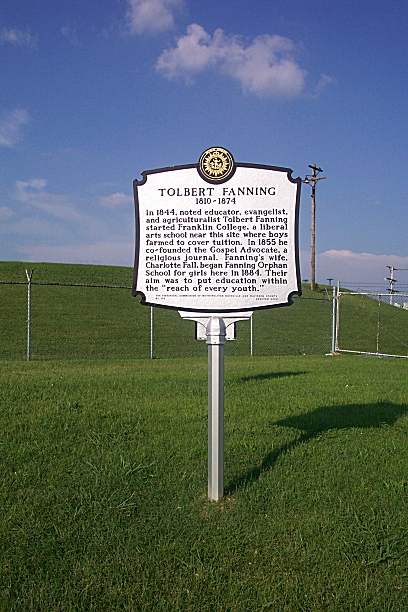
Tolbert Fanning
1810-1874
In 1844, noted educator,
evangelist,
and agriculturist Tolbert Fanning
started Franklin College, a liberal
arts school near this site where boys
farmed to cover tuition. In 1855 he
co-founded the Gospel Advocate, a
religious journal. Fanning's wife,
Charlotte Fall, began Fanning Orphan
School for girls in 1884. Their aim
was to put education within
the "reach of every youth."
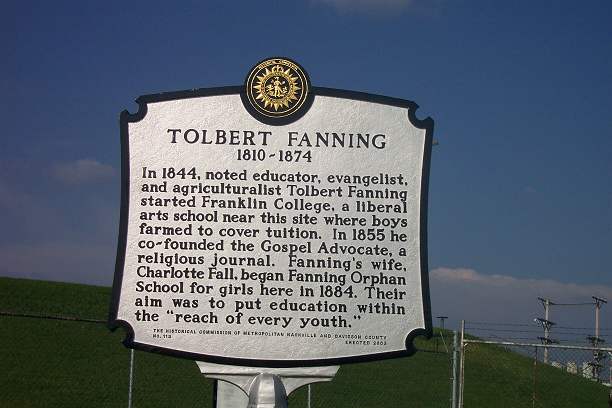
This Was Erected By The Historical Commission Of
Metropolitan Nashville And Davidson County
No. 113; Erected 2003
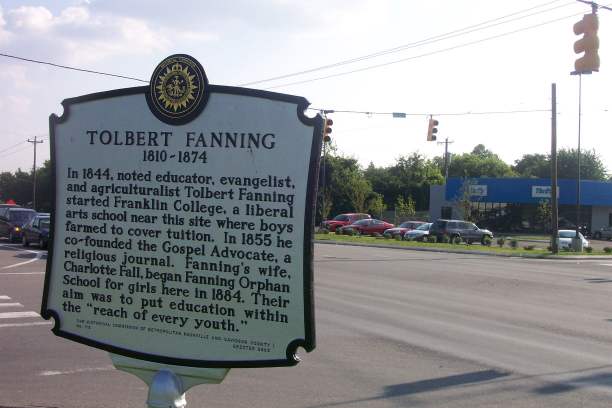
Located At The SE Cnr. of Vultee Blvd. & Briley Pkwy, Nashville, Tennessee
![]()
Lines to the Memory of Eld. T. Fanning
A deep, and saddening sound awoke,
The slumbering midnight air,
Through forest depths, the echo broke,
And mourning deep is there—
A mighty Oak, is lying low,
The forest trembles, 'neath the blow.
A vacant post on Zion's wall,
No other form may fill
A watch-man gone, whose warning voice
Was heard from hill to hill,
A soldier, tried and true, and brave
Now sleeps, but fills a victor's grave!
Dear Zion mourns, a leader gone,
A chieftain, faithful, true,
A vigilant, whose watchful eye
Kept every post in view,
The wiley foe,—the danger nigh,
Still met his ever sleepless eye.
He fought, still near his captains side,
And kept his armor bright,
And firmly held the "blood-stained" flag
Amidst the thickest fight,
His clarion voice, with trumpet tone,
Still sounded, "Honor God Alone."
No title'd honors, did he boast,
His power, was, "Truth Divine"
The "two-edged sword" his conquering host
The "Cross" his only shrine—
His victory's banner floating wide,
Bear only this, "the crucified."
The trembling hosts of Babel fled,
Before the "two-edged blade"
As on and onward still he sped.
And all its power display'd
The Law of Heaven, his battle cry,
On, soldiers on, to victory!
While loving-laurels, wreath'd his brow,
And shouts of victory came,
He calmly laid his armor by,
And bless'd his captain's name—
That name, so dear in life, in death
He honored with his dying breath.
Now folded on his peaceful breast,
Those active hands lie still,
And weeping friends are waiting now,
Sad duties to fulfil,
One true, deep mourner, lingers there,
No other heart, her grief may share.
We bow, and bless, thy cherished name
O, dear departed one!
And gratefully remember all
Thy loving heart has done,
The orphans tears, for thee shall flow
Their dearest, truest friend below.
But never, never shall we hear
Thy blessed voice again,
To higher notes, in brighter sphere,
‘Twill strike a loftier strain,
And still thy works will follow thee
And ages tell of victory,
Our mourning hearts would say Farewell,
And drop a grateful tear,
Eternity alone may tell
Thy glorious record here,
Thy crown, in that bright land afar,
Shall shine with many a brilliant star.
-Mrs. M.S. Fanning
(widowed sister-in-law of T. Fanning)
Lone Star, Texas
Gospel Advocate, August 13, 1874, p. 763-764
![]()
Three
Burial Locations
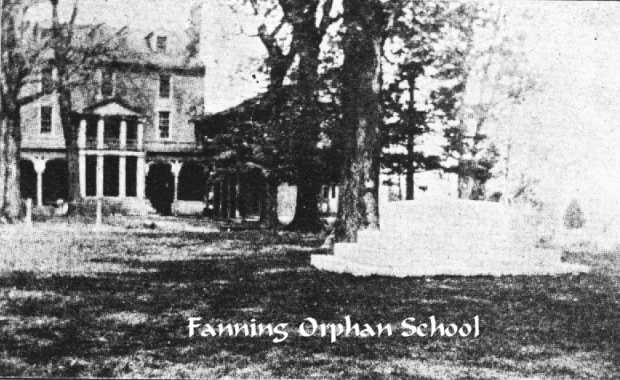
Initially, the final resting place of Tolbert Fanning was on the back of the old Elm Crag property where the home and Franklin College existed, at the southwest corner of Briley Parkway and Vultee Pike. See Historical Marker. Twenty-two years later Charlotte died, and his body was exhumed and buried with his wife at the front of the property. In 1940, the Airport Authority in Nashville purchased the property. Today one of the airport runways of the International Airport lays on top of the old farm and campus.
Tolbert and Charlotte Fall Fanning are now buried in the Mt. Olivet Cemetery, Nashville Tennessee. The cemetery is located at 1101 Lebanon Pike, Southeast of downtown Nashville. Click over to Mt. Olivet for map and location of the grave in the cemetery. This is the third location for the remains of Tolbert Fanning and the second for Charlotte. They are buried in Section 25 - Lot #56. Be sure to see map for directions in the cemetery. MAP
GPS
Coordinates
36.145523,-86.73039
Accuracy To Within 16'
Facing North
![]()
The Setting At Mt. Olivet Cemetery
![]()
Charlotte Fall Fanning
(1809-1896)
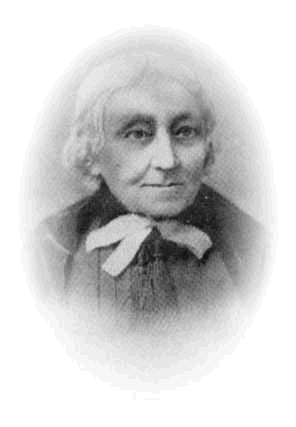
The sister of Philip S. Fall, Charlotte was the second wife of Tolbert Fanning. She was a very intelligent Christian woman, who believed in education. She and her husband, Tolbert were one of the greatest known husband/wife teams of the Restoration Movement. One prized book in my collection is The Life Of Charlotte Fall Fanning, written by Emma Page, who was the wife of T. B. Larimore. (T. B. L. was one of the Fanning's students at Franklin College.) It was a brief biography on her life, but also recorded articles that Charlotte had written. Both Charlotte and Tolbert are buried in the same grave.
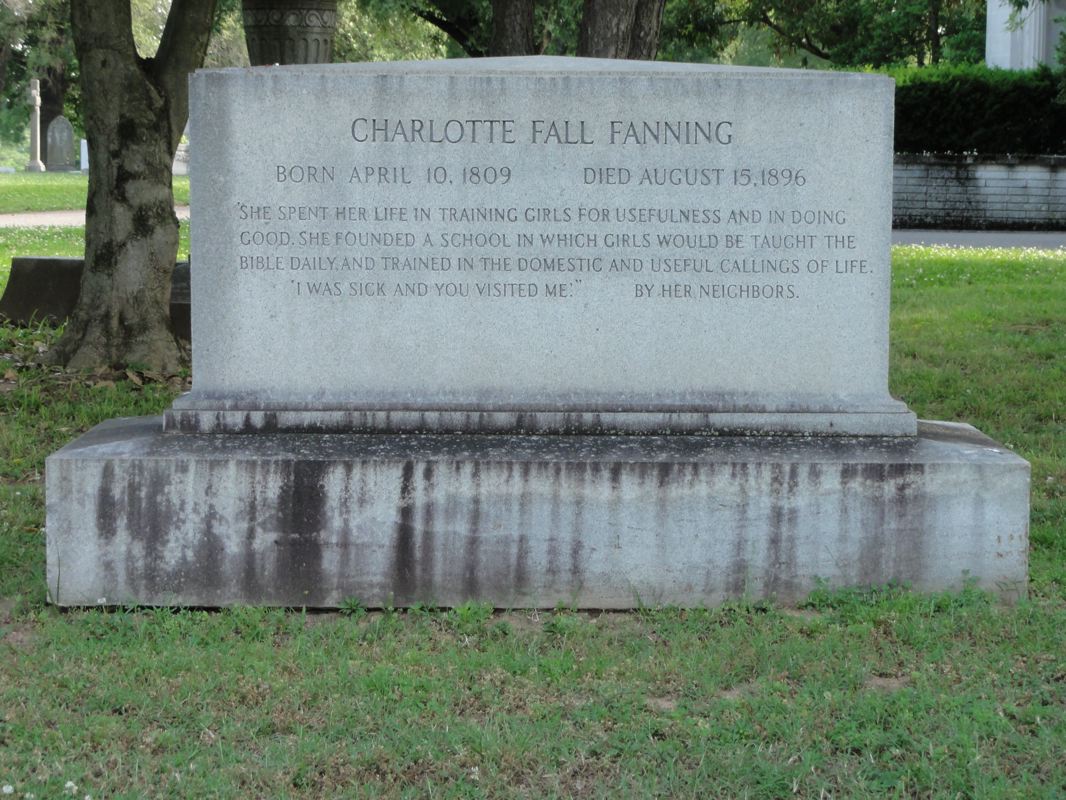
CHARLOTTE
FALL FANNING
Borne
April 10.1809 Died August 15, 1896
"She
Spent Her Life In Training Girls For Usefulness And In Doing
Good
She Founded A School In Which Girls Would Be Taught The
Bible
Daily, And Trained In The Domestic And Useful Callings Of Life.
'I
Was Sick And You Visited Me.' By Her Neighbors
![]()
Born May 10, 1810 Died May 3, 1874
Two Objects Were Near His Heart - First, To Restore The Service
Of God To The Order God Gave In The New Testament. Second, To
Place A Good, Industrial And Literary Education Within Reach
Of Every Youth. He Labored To These Ends During His Life, And
Desired His Property Devoted To Them After His Death.
![]()
See Four Biographical Sketches On Tolbert Fanning
Another Sketch On The Life Of Charlotte Fall Fanning
![]()
